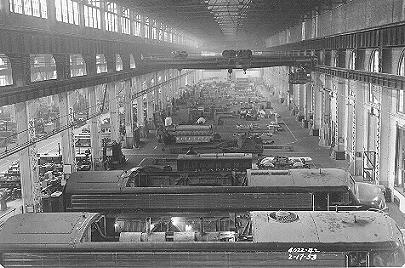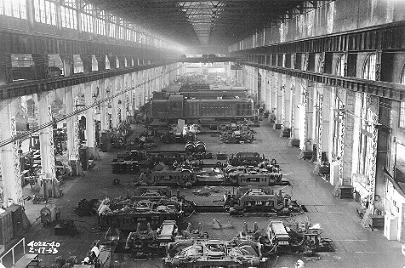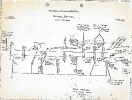The Reading Locomotive Shops: Diesel Facilities
Written by Conductor
It's February, 1953, and the Reading Company is rapidly proceeding with its dieselization program. The following series of photos from the Reading Company archives presents a tour of the diesel repair and maintenance facilities housed at the Reading Locomotive Shops. If you enjoy modeling building interiors, this series may be useful depicting what the interior of a REAL locomotive shop looks like - a couple of the Walthers Overhead Crane and EMD 567 Prime Mover kits could be put to good use here. Some lighting (perhaps one or two flashing arc welding units), maybe even a sound unit, and you'd have quite a display!
 In the left photo, we see a pair of EMD F-Units undergoing internal repairs in the foreground, while an Alco switcher is stripped of its cab directly behind the F's. The Diesel Erecting and Mechanical Repair Shops were 602 feet long by 70 feet wide, and housed seven cranes of up to 225-ton capacity for moving prime movers, trucks, traction motors, just about anything you could think of. In the left photo, we see a pair of EMD F-Units undergoing internal repairs in the foreground, while an Alco switcher is stripped of its cab directly behind the F's. The Diesel Erecting and Mechanical Repair Shops were 602 feet long by 70 feet wide, and housed seven cranes of up to 225-ton capacity for moving prime movers, trucks, traction motors, just about anything you could think of.
(Modeling note: A scene like this could be modeled with dummy units and/or those older, lower-quality units you often find for sale in cardboard boxes at train meets - some work with a Dremel, some paint and decals, and you're there!)
|
 In the view at right, taken from the opposite direction, we can see the Diesel Truck Repair Department, with a mixture of EMD, Alco and Baldwin trucks. In the background, Alco RS-3 #501 is visible, with an unidentified Baldwin AS-16 behind it. Both of these photographs show how well the shop facilities were lit with natural light. Also noticeable is how neat and orderly everything is, even though the shops are obviously a very busy place! The Reading's mechanical forces had an outstanding reputation for quality, and it is a little disputed fact that of all the locomotives turned over to Conrail by its component railroads, those owned by the Reading were in the best condition. In the view at right, taken from the opposite direction, we can see the Diesel Truck Repair Department, with a mixture of EMD, Alco and Baldwin trucks. In the background, Alco RS-3 #501 is visible, with an unidentified Baldwin AS-16 behind it. Both of these photographs show how well the shop facilities were lit with natural light. Also noticeable is how neat and orderly everything is, even though the shops are obviously a very busy place! The Reading's mechanical forces had an outstanding reputation for quality, and it is a little disputed fact that of all the locomotives turned over to Conrail by its component railroads, those owned by the Reading were in the best condition. |
 At left we see the 225-ton capacity crane at work transporting EMD F7A #269 to the Erecting Bay. The locomotive's trucks are visible on the shop floor in the foreground. It is interesting to note that Reading Yard is oriented north to south, and the main locomotive shop building is situated parallel to the yard tracks. However, the actual work bays inside the shop are oriented perpendicular to the yard tracks. This permitted more efficient routing of maintenance processes, since cranes were used to move the locomotives from bay to bay, without requiring switching manuevers. To enter and exit the locomotive shops, units were turned on one of two 75' turntables at either end of the shop hall. The locations of these turntables are marked in yellow on the below diagram. At left we see the 225-ton capacity crane at work transporting EMD F7A #269 to the Erecting Bay. The locomotive's trucks are visible on the shop floor in the foreground. It is interesting to note that Reading Yard is oriented north to south, and the main locomotive shop building is situated parallel to the yard tracks. However, the actual work bays inside the shop are oriented perpendicular to the yard tracks. This permitted more efficient routing of maintenance processes, since cranes were used to move the locomotives from bay to bay, without requiring switching manuevers. To enter and exit the locomotive shops, units were turned on one of two 75' turntables at either end of the shop hall. The locations of these turntables are marked in yellow on the below diagram.

The "Lokie Shifter" yard job was assigned the task of switching the locomotive shop. The unit assigned to this job up until the early 1960s was the #1251, an 0-6-0 steam tank switcher that was rebuilt from an early 2-8-0. This locomotive is preserved at the Railroad Musem of Pennsylvania, and Mantua makes an HO scale model of this locomotive. In later years, diesel switchers were used on this job.
|
[--pagebreak--]
  
With the locomotive body safely out of the way, the trucks are hoisted up by crane and inverted, so that the wheelsets and traction motors can be removed for maintenance and repair. Repairs will also be made to the truck frame itself while the wheelsets are removed - the center image shows a shopman grinding the welds on the truck's pedestal leg liners. The position of the brake cylinder at bottom left indicates that the truck is actually inverted as it's being worked on. The photo at right shows two Reading mechanics installing traction motor bearings on the axle by use of a jig for quick and safe installation.
|

At left we see a piston and connection rod assembly being removed from the prime mover of a locomotive. This is being accomplished through the use of one of several overhead cranes in the shops. In addition to the mammoth 225-ton crane we saw on page 1, the shop also had several cranes of 150, 50, 35 and 10 ton capacities. After the power assemblies are removed, they'll be placed in a storage rack for safekeeping while the necessary maintenance to the prime mover is performed. The glare coming through the window at right again shows how natural lighting was used for illumination.
|
[--pagebreak--]
 Extreme care was always taken to prevent damage to parts while undergoing repair. It is critical to the reliable operation of a diesel locomotive that all parts fit together perfectly and retain their specified shape without any dents, cracks or other deformities, or else breakdowns can occur while in service. In the view at right, we see an "electric platform lift jack" (the Reading's fancy term for a forklift) being used to move power assemblies between repair stations in the shops, being held upright to keep everything in alignment. This image provides an interesting view of the wood-block floor, a common feature in older manufacturing facilities that can still be seen in use in some locations today. Extreme care was always taken to prevent damage to parts while undergoing repair. It is critical to the reliable operation of a diesel locomotive that all parts fit together perfectly and retain their specified shape without any dents, cracks or other deformities, or else breakdowns can occur while in service. In the view at right, we see an "electric platform lift jack" (the Reading's fancy term for a forklift) being used to move power assemblies between repair stations in the shops, being held upright to keep everything in alignment. This image provides an interesting view of the wood-block floor, a common feature in older manufacturing facilities that can still be seen in use in some locations today. |

Once all the necessary repairs have been completed, the task of re-assembling the prime mover to get the locomotive ready for service begins. At left, we see one of the mechanics supervising the process. The power assemblies are held upright in the storage rack, and the overhead crane is beginning to hoist it up so that it can be installed in the prime mover of Alco S-2 switcher #43. These units were utilized primarily in the Philadelphia and Wilmington areas, but like all locomotives on the Reading system, were returned to the main shop for heavy repairs. Note that the body is still off its trucks; after internal assembly is complete, the hood will be reinstalled, and the locomotive will again "fly" down the shop to be placed on its trucks.
|

At right is another view of re-installing power assemblies in the prime mover, this time in an EMD model 567. Again, the overhead crane is being used, not only to prevent damage, but also and more importantly, for SAFETY. Locomotives are big, heavy, dangerous pieces of equipment, and it only takes a moment for an accident to happen that could cause injury or even death. Like most railroads, the Reading took workplace safety very seriously, with constant meetings and rallies to stress on-the-job safety. There was even a Safety Committee at the shops to help raise awareness. As a result of these efforts, the Reading was awarded the coveted Harriman Safety Award in 1952 and 1953 for the best safety record among eastern railroads.
|
[--pagebreak--]
In many ways, diesel locomotives are just like our cars. In active service, they get dirty, and to keep them running at peak efficiency, frequent cleaning of parts and maintenance of filters is essential. One significant difference is that with locomotives, filters are often more durable, and can be cleaned and re-used prior to replacement. The views below show how the Reading accomplished this task. In the photo at left, we see the cleaning tanks and material basket for cleaning diesel parts. One tank holds cleaning solution, and the other holds rinse water. Both tanks are agitated to help get the parts clean. The photo at right shows the cleaning room. This is where the filters were cleaned and oiled before being re-installed in a locomotive.
  |
A place for everything and everything in its place! The photos below show the meticulous organization that enabled the Reading to keep its locomotives in peak condition. The left photo shows the storage rack and cabinets for various locomotive parts: Cylinder head and liner seals, gaskets and parts. The right hand photo shows the tool room, where tools used to effect repairs on locomotives were kept, and signed out by shop personnel using small brass tool checks. Precision tools were kept in the cabinets in the rear of the photo.
  |
[--pagebreak--]

After the heavy repairs have been completed and the hood replaced, the shop crews go to work on the finishing touches to the little Alco. A distinctive feature of Reading locomotives is the painting of a safety slogan on or near the locomotive steps as an ever-present reminder to train crews to work safely. First-generation diesels were commonly stenciled with the "Safety is Your Job" slogan seen being applied at right; second generation units bore the slogan "Safety Always" that was found in the step wells of both the front and rear of the locomotive. Recreating the image at right would be a unique and unmistakably Reading touch for your modeled shop scene.
We hope you've enjoyed this brief tour of the Reading Locomotive Shops. Although the facility has long been shuttered, it truly was, in the words of noted Reading historian Jim Holton, a "Crucible of Excellence," where thousands of skilled workers kept the locomotives maintained and ready for service, with an unparalleled sense of pride and dedication.
|
Did You Know?
December 5, 1833
The Philadelphia and Reading (P&R) Railroad began operations.
Downloads
Operations Information
 A variety of Reading Company operations related documents, etc. that may be of use in your modeling efforts.
A variety of Reading Company operations related documents, etc. that may be of use in your modeling efforts.
Operations Paperwork
 A variety of Reading Company operations paperwork, such as train orders, clearance forms, etc. that will help you operate your Reading layout in a prototypical manner.
A variety of Reading Company operations paperwork, such as train orders, clearance forms, etc. that will help you operate your Reading layout in a prototypical manner.
Timetables, Rulebooks, Etc.
 Public Timetables, Employe Timetables, and Rulebooks that provide much useful operational information.
Public Timetables, Employe Timetables, and Rulebooks that provide much useful operational information.
Modeling Goodies
 Signs, billboards, and other FREE goodies for your use. We ask only that you help spread the word about The Reading Modeler!
Signs, billboards, and other FREE goodies for your use. We ask only that you help spread the word about The Reading Modeler!
Rolling Stock Reference

